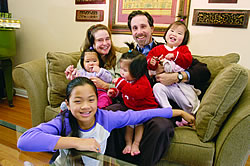|
Issue Contents :: Feature :: Sister Act :: [ 1 2 ]
|
Puzzles and books offer some moments of calm in this otherwise very busy home. |
The Youtz family returned to China in 2004 to introduce Sophie, then age 9, to her country of origin. They arranged a visit to the Mother’s Love orphanage. For Sophie, it was a homecoming of sorts; she had been among the first babies adopted from the facility in 1995.
While touring the playrooms, Sophie and her mother spied a crib with three babies lying in a row, crosswise. With dandelion puffs of black hair, the triplets lay swaddled side-by-side. “What will happen to them?” they asked the staff. “Will they be able to stay together?”
Chinese adoptions can take months. A family must first gather paperwork, then be matched with a child, and then await approval from the China Center for Adoption Affairs to travel to China. Though challenging, the process is considered consistent and predictable, making China the largest, single source of international adoption for Americans since their facilitation in 1993. Last year, the 50,000th Chinese child was adopted by an American family. Ninety-five percent of those adopted are girls.
After a month of soul-searching, Youtz and Child began assembling their dossier, which included birth, marriage, and financial certificates; fingerprints; FBI clearance; and a family assessment. Even with the couple’s longtime experience with the country, the adoption process proved nerve-wracking. Allowing the international adoption of twins is uncommon enough for the Chinese government; extremely rare, therefore, would be approval for triplets. But on July 1, 2005, word finally arrived from their adoption agency in New York, the Gladney Center for Adoption. “You have a match!” their case worker told them. It was the Plum sisters.
A few weeks later, a full 13 months from their first glimpse of the triplets, the family returned to Nanning to claim their new daughters. Nora, Alice, and Anna, distinguishable only by the colored scrunchies that tied up their fountain ponytails, arrived in New Jersey last August 28.
In quick succession, Youtz and Child purchased a minivan, reassigned their home’s upstairs bedrooms, and, with the help of friends, neighbors, and members of FCC, assembled three car seats, three high chairs, and three cribs. “We joined Costco,” said Youtz, to buy diapers and wet wipes in bulk. Family members early on cycled through the home to help out, but now, with the aid of a live-in helper, a routine—albeit a hectic one—has been established. A rice cooker simmers around the clock, preparing the congee, a watery rice porridge the girls grew accustomed to eating in the orphanage.
 As the triplets settle in, their distinct personalities are emerging. Nora is Lao Da, or “Old Big”—the Chinese nickname for the first born. The largest and most confident of the three, she clearly is the boss. When her middle sister, Alice—called Lao Er, or “Old Second”—starts to cry, Nora finds a pacifier and pushes it into her mouth. When it’s time to go outside, she gathers all three pairs of shoes. Anna, the most vocal, is Lao San, or “Old Third.” The girls adore their older sister, following Sophie through the house like ducklings (which alternately amuses and annoys her). As the triplets settle in, their distinct personalities are emerging. Nora is Lao Da, or “Old Big”—the Chinese nickname for the first born. The largest and most confident of the three, she clearly is the boss. When her middle sister, Alice—called Lao Er, or “Old Second”—starts to cry, Nora finds a pacifier and pushes it into her mouth. When it’s time to go outside, she gathers all three pairs of shoes. Anna, the most vocal, is Lao San, or “Old Third.” The girls adore their older sister, following Sophie through the house like ducklings (which alternately amuses and annoys her).
With the busyness of their trip to China and their first weeks at home, it wasn’t until September that the couple had time to translate the handwritten inscriptions pinned to the triplets’ blankets. Written in an arcane style, the symbols appeared to have been penned by a village scribe, rather than the babies’ birth parents. The birth date was expressed using a lunar farming calendar. When Youtz, with the help of his Chinese tutor, deciphered the exact translation, he felt a chill. In addition to asking that each girl be raised to adulthood, the notes also expressed hope that the honorable people who raised each one would “bring back the child to meet her relatives.”
Somewhere in a rural village of the Guangxi Autonomous Region is a woman who gave birth to three, healthy babies. Someday, says Youtz, his family hopes to find the birth parents and tell them the sisters were raised together.
Meanwhile, there is so much to learn.
“Zou-yi-zou,” says Child, taking Alice’s hands. “Walk a step.” Alice lurches along with the halting steps of a toddler.
The journey of a thousand miles begins with a single step, a Chinese philosopher once said. And so the journey of the Youtz sisters begins.
Lindy Washburn ’75 and David Youtz are members of the committee planning the centennial celebration for the Oberlin Shansi Association, to take place during commencement weekend 2008. Portions of this story originally appeared in The Record in Hackensack, N.J.
|





